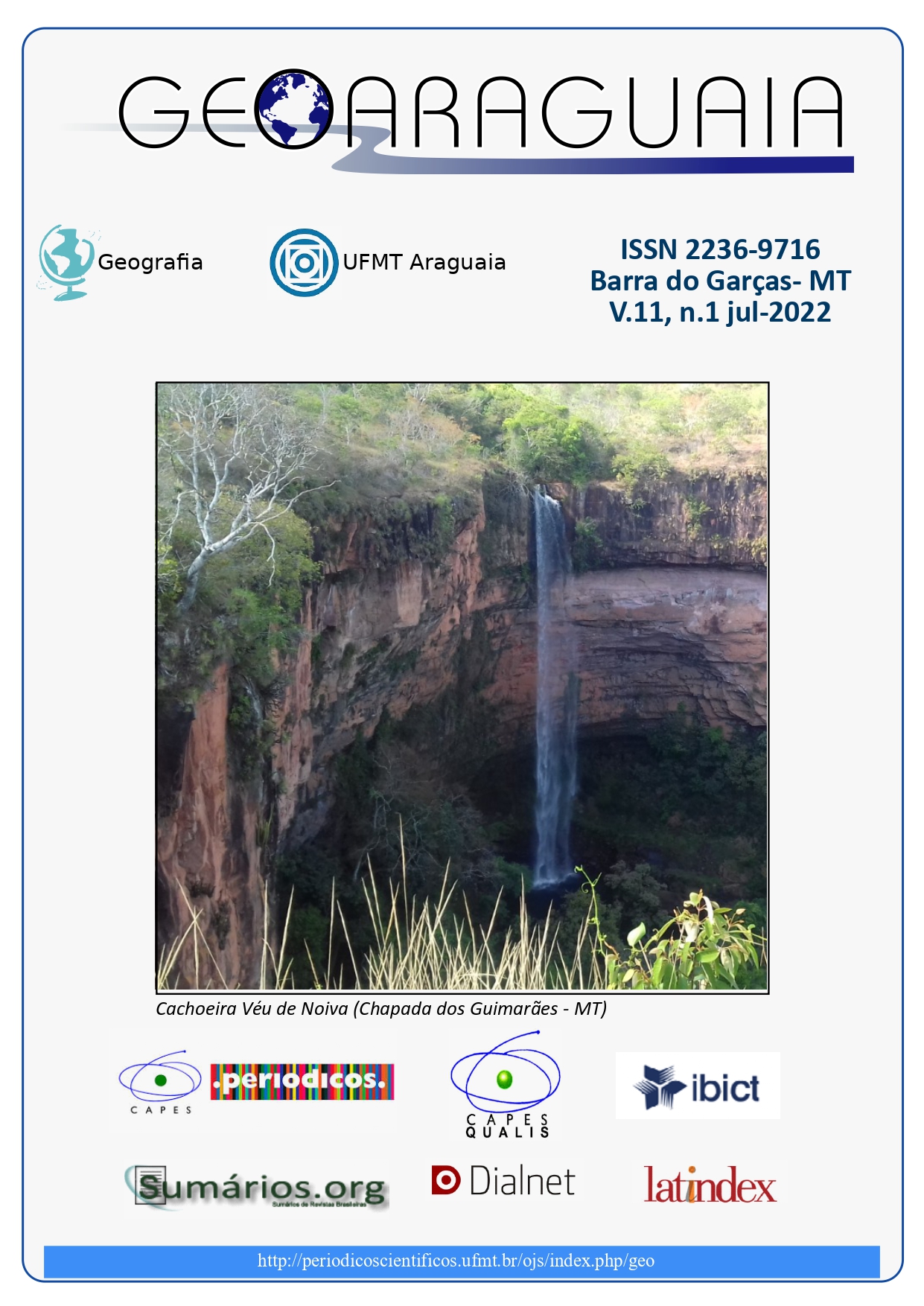Investigation of Geomorphological Forms of Goyjah Bel Basin in Ahar Plain
Palavras-chave:
Basin, Plain, Geomorphology, Facies, Ahar Plain, HillResumo
Os estudos geológicos e geomorfológicos, como estudos básicos, desempenham um papel fundamental em projetos de bacias hidrográficas, proteção do solo e gestão de inundações. A bacia de Goyjah Bel está localizada dez quilômetros a sudoeste do Condado de Ahar. A área de estudo faz parte da bacia hidrográfica do rio Aharchay, que se junta ao rio Qarah Su e ao rio Aras. A bacia mencionada está localizada nas zonas estruturais do Alborz e do Irã Central e é composta por várias unidades rochosas-sedimentares devido à sua vastidão e localização geográfica. O aspecto morfológico desta bacia é afetado por duas zonas mencionadas e pelo movimento de estruturas na região noroeste-sudeste. Na formação dessas estruturas, fatores como a colisão das placas Iraniana e Turan, o desempenho de falhas de empuxo e, finalmente, o desempenho de falhas de ataque-deslizamento noroeste-sudeste têm desempenhado um papel. A morfologia da bacia inclui principalmente montanhas e colinas. Trata-se de uma pesquisa descritiva e analítica baseada em estudos de campo e bibliotecários. Os dados espaciais desta pesquisa incluíram as imagens de satélite, cartas topográficas (1.25000), fotografias aéreas e cartas geológicas (1.100000) cujos tipos, unidades e fácies da geomorfologia foram por eles determinados. Na área de estudo foram identificadas três unidades, três tipos e sete fácies geomorfológicas. A unidade geomorfológica mais dominante foi a unidade Hill com área de 3665,1 hectares, ocupando 49% do total da bacia. Além da unidade de Monte, a unidade de montanha também possui uma área muito grande, mas a unidade de planície e rio cobre uma área pequena. Várias formas morfológicas na área de estudo incluem anticlinais, sinclinais, cones aluviais, barragens sedimentares, canais, valas, sulcos, deslizamentos de terra e vários tipos de movimentos de colapso da parede do canal.
Referências
Khodami, M.; Mahboubi, A.; Mousavi Harami, R.; Feyznia, S.; Analysis of Rock Facies and Sedimentary Model of Latshour River, Southeast of Tehran, Journal of Earth Sciences, Volume 16, No. 63, 2007. pp. 110-123.
Refahi, H.; Water Erosion and Its Control, Institute of Publishing and Printing, University of Tehran, 2003. P.671.
Rostamizadeh, G.; Sedimentology and Geomorphology of Beido Basin from Esfarāyen, M.Sc. Thesis, Faculty of Science, Ferdowsi University of Mashhad, 2003.
Geological Survey and Mineral Exploration of Iran, Geological Map with A Scale Of 1.100000, 2004.
Geological Survey and Mineral Exploration of Iran, Geological Map with A Scale Of 1.250000,
Geological Survey and Mineral Exploration of Iran, Aerial Photographs with A Scale Of 1.40000
Shayan, S.; Zare, Gh.; Explaining the Concept of Erosion from The Perspective of Geomorphology and Comparing It with The Perspective of Natural Resources, Journal of Environmental Erosion Research, Hormozgan University, 1st Year, No. 1., 2011.
Nabavi, M.H.; An Introduction to the Geology of Iran, Geological Survey of Iran, 1355. p. 109.
Motamed, A.; Sedimentology, Tehran University, 2003. pp.376.
Nabavi M.H.; The history of the Geological Survey of Iran, Geological Survey of Iran, 1976. pp.109.
Giovanni, B.; Crosta, Paolo Frattini; Controls on Modern Alluvial Fan Processes in The Central Alps, Northern Italy.V.29, Is.3, 2004. PP.267-293.
Harvey, C.L.; Dixon, H.; And Hannaford, J.; An Appraisal of The Performance of Data Infilling Methods for Application to Daily Mean River Flow Records in the UK. Hydrology Research, In Press, Doi:10.2166 /Nh.2012.110, 2012.
Harvey, A.M.; "The Occurrence and Role of Arid Zone Alluvial Fans", In: D. S. G. Thomas. (Ed.). Arid Zone Geomorphology. Belhaven Press, 1989. pp.136-158.
Harvey, K.D.; Pilon, P.J.; Yuzyk, T.R.; Canada’s Reference Hydrometric Basin Network (RHBN), 1999.
Partnerships in Water Resources Management, Proceedings of the CWRA 51st Annual Conference, Nova Scotia.
Keller E.A.; Pinter N.; Active Tectonics: Earthquakes, Uplift and Landscapes. Prentice Hall, New Jersey, 1996.
Keller, E.A.; Pinter, N.; "Active Tectonics: Eathquake Uplift, And Landscape", Prentice Hall, Newjersey, 2002.
Lepera, E.; Sarriso–Valvo, M.; Weathering, Erosion and Sediment Composition in A High Gradient River, Alabria, Italy, Eart H Surface Process and Landforms, Vol.25, PP.277-292, 2000.
Li. M, Y.W; “Effects of Landforms on The Erosion Rate in a Small Basinby The Cs Tracing Method”, Journal of Environmental Radioactivity, Vol. 101, No. 5. 2010.
Ritter, J.B.; Coonfare, C.; Miller, J.R.; Husek, J.; The Alluvial Fan Stratigraphy of Buena Vista Valley, 1996.
North Central Nevada: Implications for A Synchronous Geomorphic Response on Alluvial Fans in A Semi-Aridžclimate. In: Adams, K.D., Fontaine, S.A. Eds., Quaternary History, Isostatic Rebound and Active Faulting in The Lake Lahontan Basin, Nevada and California. Friends Of the Pleistocene Pacific Cell, Field Trip Guidebook, University of Nevada, Reno, App 4, pp. 14.
Schumm, S.A.; River Response to Base Level Change, Implications for Sequence Stratigraphy, The Journal of Geology. V.101. pp.279-294, 1987.
Walker, R. T.; "A remote sensing study of active folding and faulting in southern Kerman province, S.E. Iran", Journal of Structural Geology, 28: PP. 654-668, 2006.
Downloads
Publicado
Edição
Seção
Como Citar
Licença
A Revista Geoaraguaia poderá solicitar alterações de ordem normativa, ortográfica e gramatical, com vistas a manter o padrão culto da língua. Se necessário, alguns ajustes normativos podem ser feitos pela revista, porém respeitando o estilo dos autores.
As provas finais não serão enviadas aos autores.
As opiniões emitidas pelos autores dos artigos são de sua exclusiva responsabilidade.





 A revista
A revista